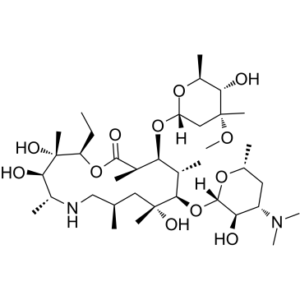Physicochemical Properties
| Molecular Formula | C37H70N2O12 |
| Molecular Weight | 734.9579 |
| Exact Mass | 734.492 |
| CAS # | 76801-85-9 |
| Related CAS # | 83905-01-5 (Azithromycin); 117772-70-0 (Azithromycin dihydrate; Azitro; CP 62993; CP-62993; CP62993; Goxal; Odaz; Ribotrex; Toraseptol; Ultreon; XZ-450; XZ450; XZ 450; Zenstavion; Zithromax; Zmax); 41342-53-4 (Erythromycin Ethylsuccinate) 7704-67-8 (Erythromycin Thiocyanate); 16667-03-1 (Erythromycin glutamate) |
| PubChem CID | 9810601 |
| Appearance | White to off-white solid powder |
| Density | 1.2±0.1 g/cm3 |
| Boiling Point | 815.2±65.0 °C at 760 mmHg |
| Melting Point | 126-136ºC |
| Flash Point | 446.8±34.3 °C |
| Vapour Pressure | 0.0±0.6 mmHg at 25°C |
| Index of Refraction | 1.536 |
| LogP | 3.11 |
| Hydrogen Bond Donor Count | 6 |
| Hydrogen Bond Acceptor Count | 14 |
| Rotatable Bond Count | 7 |
| Heavy Atom Count | 51 |
| Complexity | 1120 |
| Defined Atom Stereocenter Count | 18 |
| SMILES | O([C@@]1([H])[C@@]([H])([C@]([H])(C([H])([H])[C@@]([H])(C([H])([H])[H])O1)N(C([H])([H])[H])C([H])([H])[H])O[H])[C@@]1([H])[C@@](C([H])([H])[H])(C([H])([H])[C@@]([H])(C([H])([H])[H])C([H])([H])N([H])[C@]([H])(C([H])([H])[H])[C@]([H])([C@@](C([H])([H])[H])([C@@]([H])(C([H])([H])C([H])([H])[H])OC([C@]([H])(C([H])([H])[H])[C@]([H])([C@]1([H])C([H])([H])[H])O[C@@]1([H])C([H])([H])[C@](C([H])([H])[H])([C@]([H])([C@]([H])(C([H])([H])[H])O1)O[H])OC([H])([H])[H])=O)O[H])O[H])O[H] |
| InChi Key | HRKNNHYKWGYTEN-HOQMJRDDSA-N |
| InChi Code | InChI=1S/C37H70N2O12/c1-14-26-37(10,45)30(41)23(6)38-18-19(2)16-35(8,44)32(51-34-28(40)25(39(11)12)15-20(3)47-34)21(4)29(22(5)33(43)49-26)50-27-17-36(9,46-13)31(42)24(7)48-27/h19-32,34,38,40-42,44-45H,14-18H2,1-13H3/t19-,20-,21+,22-,23-,24+,25+,26-,27+,28-,29+,30-,31+,32-,34+,35-,36-,37-/m1/s1 |
| Chemical Name | (2R,3S,4R,5R,8R,10R,11R,12S,13S,14R)-11-[(2S,3R,4S,6R)-4-(dimethylamino)-3-hydroxy-6-methyloxan-2-yl]oxy-2-ethyl-3,4,10-trihydroxy-13-[(2R,4R,5S,6S)-5-hydroxy-4-methoxy-4,6-dimethyloxan-2-yl]oxy-3,5,8,10,12,14-hexamethyl-1-oxa-6-azacyclopentadecan-15-one |
| Synonyms | Azaerythromycin A; Desmethyl Azithromycin |
| HS Tariff Code | 2934.99.9001 |
| Storage |
Powder-20°C 3 years 4°C 2 years In solvent -80°C 6 months -20°C 1 month |
| Shipping Condition | Room temperature (This product is stable at ambient temperature for a few days during ordinary shipping and time spent in Customs) |
Biological Activity
| Targets | Macrolide antibiotic |
| ln Vitro | Though phenotypic and target-based high-throughput screening approaches have been employed to discover new antibiotics, the identification of promising therapeutic candidates remains challenging. Each approach provides different information, and understanding their results can provide hypotheses for a mechanism of action (MoA) and reveal actionable chemical matter. Here, we describe a framework for identifying efficacy targets of bioactive compounds. High throughput biophysical profiling against a broad range of targets coupled with machine learning was employed to identify chemical features with predicted efficacy targets for a given phenotypic screen. We validate the approach on data from a set of 55 000 compounds in 24 historical internal antibacterial phenotypic screens and 636 bacterial targets screened in high-throughput biophysical binding assays. Models were built to reveal the relationships between phenotype, target, and chemotype, which recapitulated mechanisms for known antibacterials. We also prospectively identified novel inhibitors of dihydrofolate reductase with nanomolar antibacterial efficacy against Mycobacterium tuberculosis. Molecular modeling provided structural insight into target-ligand interactions underlying selective killing activity toward mycobacteria over human cells [1]. |
| References | [1]. Linking High-Throughput Screens to Identify MoAs and Novel Inhibitors of Mycobacterium tuberculosis Dihydrofolate Reductase. ACS Chem Biol. 2017 Sep 15; 12(9): 2448–2456. |
Solubility Data
| Solubility (In Vitro) |
Ethanol : ~100 mg/mL DMSO : 33.33~50 mg/mL ( 45.35 ~68.03 mM ) |
| Solubility (In Vivo) |
Solubility in Formulation 1: ≥ 2.5 mg/mL (3.40 mM) (saturation unknown) in 10% DMSO + 40% PEG300 + 5% Tween80 + 45% Saline (add these co-solvents sequentially from left to right, and one by one), clear solution. For example, if 1 mL of working solution is to be prepared, you can add 100 μL of 25.0 mg/mL clear DMSO stock solution to 400 μL PEG300 and mix evenly; then add 50 μL Tween-80 to the above solution and mix evenly; then add 450 μL normal saline to adjust the volume to 1 mL. Preparation of saline: Dissolve 0.9 g of sodium chloride in 100 mL ddH₂ O to obtain a clear solution. Solubility in Formulation 2: ≥ 2.5 mg/mL (3.40 mM) (saturation unknown) in 10% DMSO + 90% (20% SBE-β-CD in Saline) (add these co-solvents sequentially from left to right, and one by one), clear solution. For example, if 1 mL of working solution is to be prepared, you can add 100 μL of 25.0 mg/mL clear DMSO stock solution to 900 μL of 20% SBE-β-CD physiological saline solution and mix evenly. Preparation of 20% SBE-β-CD in Saline (4°C,1 week): Dissolve 2 g SBE-β-CD in 10 mL saline to obtain a clear solution. Solubility in Formulation 3: ≥ 2.5 mg/mL (3.40 mM) (saturation unknown) in 10% DMSO + 90% Corn Oil (add these co-solvents sequentially from left to right, and one by one), clear solution. For example, if 1 mL of working solution is to be prepared, you can add 100 μL of 25.0 mg/mL clear DMSO stock solution to 900 μL of corn oil and mix evenly. Solubility in Formulation 4: 10% DMSO+40% PEG300+5% Tween-80+45% Saline: ≥ 2.5 mg/mL (3.40 mM) (Please use freshly prepared in vivo formulations for optimal results.) |
| Preparing Stock Solutions | 1 mg | 5 mg | 10 mg | |
| 1 mM | 1.3606 mL | 6.8031 mL | 13.6062 mL | |
| 5 mM | 0.2721 mL | 1.3606 mL | 2.7212 mL | |
| 10 mM | 0.1361 mL | 0.6803 mL | 1.3606 mL |
